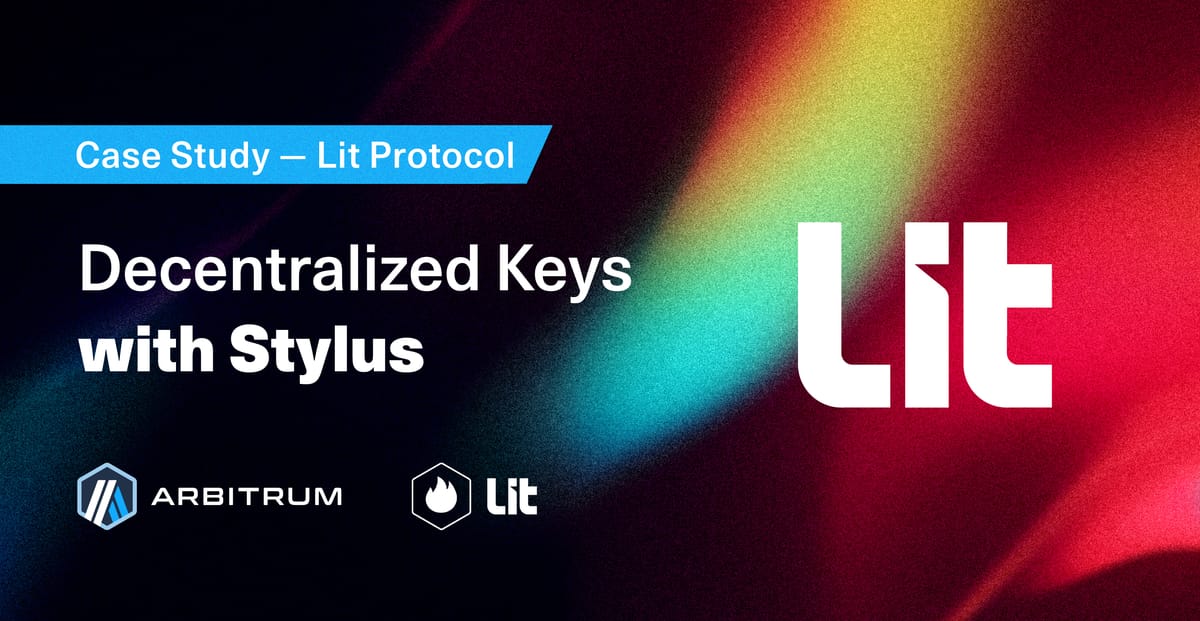How Lit Protocol Coordinates Decentralized Key Management with Stylus

All meaningful onchain actions start with a secret key, including moving funds, rotating keys and decrypting files. To make a transaction happen, users must either sign everything themselves or hand their keys over to a service provider.
Although this method works, it doesn’t scale across chains, and it is not possible to encode policy around why and when a signature should happen.
Lit Protocol is a decentralized key management network that enables signing and encryption. This means that developers can now program their signatures and decryptions to follow rules such as who can sign, for what purpose, and under which conditions on a decentralized network. Signatures will only be given if preset criteria is met, and no single server ever holds the key.
How Does Lit Protocol Work?
Lit Protocol operates a distributed signing and key management network using Multi-Party Computation (MPC) Threshold Signature Schemes (TSS) and Trusted Execution Environment (TEE) nodes. The network has the capability to create multiple decentralized key pairs, then governs how those keys are used.
This means that developers have the ability to mint as many keys as needed. Lit Protocol’s nodes each hold a share of a key and only produce a combined signature when the onchain policy is met.
The chain acts like a neutral database where predetermined policies and permissions live, and signing / decryption can be achieved across multiple ecosystems without needing to put custody into the hands of any one party or centralized bots or servers.
The blockchain is there as part of the stack to remove another single point of control, according to David Sneider, co-founder of Lit Protocol. “The blockchain is the database, without it [the blockchain], there would be a point of centralization,” Sneider said.
With clear policies defined onchain and signatures produced by the network, teams now have the ability to grant precise, scoped authority. Users are also able to utilize the distributed signing and key management network for interopability, to optimize returns on specific assets without having to hand over their entire wallet, private data, and AI automation. Sending items across different blockchains are also simplified, as transactions will not need to be manually signed by multiple key holders.
How Does Lit Protocol Use Stylus?
Enabling decentralized key management means running complicated cryptography onchain. Stylus introduces a WebAssembly VM alongside the EVM on Arbitrum, so contracts written in Rust can run natively and interoperate with Solidity. Prior to using Stylus, the Lit team was converting the Rust programming language into Solidity just to deploy onchain, this process was slow and brittle, and compromises on speed had to be made to ensure correctness.
“We were converting a lot of Rust libraries to Solidity ourselves, and then realized we didn’t have to do that because of Stylus,” Sneider said.
With Stylus, the Lit team was able to natively run Rust smart contracts onchain, making it possible to run battle-tested Rust libraries (such as hashes and elliptic curves) as-is and still execute them onchain. Stylus isn’t just developed for convenience, instead, for teams like Lit Protocol, it is a structural enabler. The MultiVM model means Rust and Solidity can live side-by-side, and the Arbitrum chain itself acts as a configurable substrate for those who are building on top of it.
